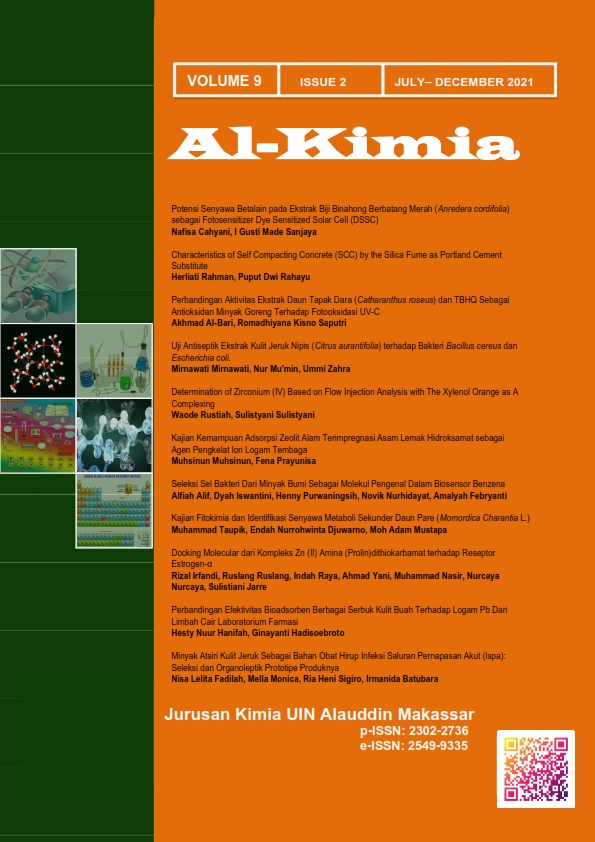Kemampuan Adsorpsi Zeolit Alam Terimpregnasi Asam Lemak Hidroksamat sebagai Agen Pengkelat Ion Logam Tembaga
Abstract
One of the way to recycle heavy metals in the prevention of environmental pollution is by using a solid-liquid extraction method through the impregnation mechanism of chelating agent in the adsorbent to increase its ability to bind heavy metal ions. In this study, the impregnation of fatty hydroxamic acids (FHA) successfully carried out on active natural zeolite (ZAA). This is has been done to increase the maximum adsorption capacity of ZAA towards heavy metals. The purpose of this study was to examine the adsorption ability of FHA impregnated onto ZAA as a chelating agent in copper metal ions by using column chromatography. This column contains FHA, which synthesized from crude rice bran oil and impregnated onto ZAA. There are several parameters were investigated, they are, the effect of FHA concentration, mass of FHA-ZAA resin and pH of the metal ion sample. From this study, the concentration of FHA impregnated on the zeolite surface reached 41.60%. The optimum conditions for Cu(II) adsorption by FHA-ZAA were as follows: mass ratio of FHA-ZAA resin with Cu(II) concentration (g : ppm) was 1:100 and the optimum condition of Cu(II) ion was at pH 5Downloads
References
Arif Z. 2011. Karakterisasi dan modifikasi zeolit alam sebagai bahan media pendeteksi studi kasus: kromium heksavalen [Tesis]. Bogor (ID): Institut Pertanian Bogor.
Blattner, C. 2005. Biocatalysis using lipase immobilised in organogels in supercritical carbon dioxide. Disertasi. University of Regensburg.
Buasri A, Chaiyut N, Phattarasirichot K, Yongbut P, Nammueng L. 2008. Use of natural clinoptilolite for the removal of lead (II) from wastewater in batch experiment. Chiang Mai J. Sci. 35(3): 447-456.
Haron, M.J., Jahangirian, H., Silong, S., Yusof, N.A., Kassim, A., Moghaddam, R.R., Peyda, M., Abdollahi, Y., Amin, J., Gharayebi, Y. 2012. Copper extraction by fatty hydroxamic acids derivatives synthesized based on palm kernel oil. J. Oleo Sci. 61(4): 189-195.
Hoidy WH, Ahmad MB, Mulla EAJA, Ibrahim NAB. 2009. Synthesis and characterization of organoclay from sodium montmorillonite and fatty hydroxamic acids. Am.J.Appl.Sci. 6(8): 1567-1572.
Khawassek, Y.M., Cheira, M.F., Mahmoud, G.M. 2012. Studies on the extraction of copper (II) by pyrazoloquinazolinone derivatives from aqueous solutions. Res.J.Chem.Sci. 2(6): 30-37.
Kiran KTN, Revanasiddappa HD. 2003) Rapid and sensitive spectrophotometric determination of trace amounts of iron(III) using leuco Xylene cyanol FF. Anal. Bioanal. Chem. 376(7): 1126-1130.
Lee TS, Jeon DW, Kim JK, Hong SI. 2001. Formation of metal complex in a poly (hydroxamic acid) resin bead. Fibers and Polymers. 2(1):13-17.
Lin J, Zhan Y, Zhu Z. 2011. Adsorption characteristics of copper (II) ions from aqueous solution onto humic acid-immobilized surfactant-modified zeolite. Physicochem. Eng. Aspects. 384(1-3): 9-16.
Moghaddam, M.G., Ahmad, F.B.H., Basri, M., Rahman, M.B.A. 2010. Lipase-Catalyzed Esterification of Betulinic Acid Using Anhydride in Organic Solvent Media: Study of Reaction Parameters. Journal of Applied Sciences. 10(4):337-342.
Muhsinun, Prayunisa F. 2020. Optimasi Sintesis Asam Lemak Hidroksamat Menggunakan Minyak Mentah Dedak Padi. Jurnal Kimia Mulawarman. 18(1): 38-43.
Nasrollahzadeh M, Ehsani A, Rostami-Vartouni A. 2014. Ultrasound-promoted green approach for the synthesis of sulfonamides using natural, stable and reusable Natrolite nanozeolite catalyst at room temperature. Ultrasonics Sonochemistry. 21(1): 275-282.
Suhendra D, Yunus WMZ, Haron MJ, Basri M, Silong S. 2005. Enzymatic synthesis of fatty hydroxamic acid from palm oil. J. Oleo Sci. 54(1): 33-38.
Suhendra, D., Yunus, W.M.Z., Haron, M.J., Basri, M., Silong, S. 2006. Separation and preconcentration of copper ion by fatty hydroxamic acid immobilized onto Amberlite XAD-4. Indo. J. Chem. 6(2): 165-169.
Wijayanti IE. 2014. Biosensor antioksidan menggunakan ekstrak protein dari bakteri Deinococcus Radiodurans terimobilisasi pada nanopartikel zeolit. [Tesis]. Bogor (ID): Institut Pertanian Bogor.
Yu Y, Shaptera JG, Popelka-Filcoff R, Bennett JW. 2014. Copper removal using bio-inspired polydopamine coatednatural zeolites. J. Hazard. Mat. 273: 174–182.
Authors who publish with this journal agree to the following terms:
1) Authors retain copyright and grant the journal right of first publication with the work simultaneously licensed under a Creative Commons Attribution License that allows others to share the work with an acknowledgement of the work's authorship and initial publication in this journal.
2) Authors are able to enter into separate, additional contractual arrangements for the non-exclusive distribution of the journal's published version of the work (e.g., post it to an institutional repository or publish it in a book), with an acknowledgement of its initial publication in this journal.
3)Authors are permitted and encouraged to post their work online (e.g., in institutional repositories or on their website) prior to and during the submission process, as it can lead to productive exchanges, as well as earlier and greater citation of published work (See The Effect of Open Access).


